This Piadina recipe is the authentic version of the Italian flatbread that originated in Emilia Romagna. It is a flat, thin, and crumbly bread born as the poor people's bread, as it has no yeast. However, La Piadina Romagnola is very tasty as it is made with lard instead of olive oil. It is used to make warm sandwiches, the most traditional Romagna is filled with Squacquerone cheese, prosciutto, rocket-arugula salad, and tomatoes.

Jump to:
What is Piadina
Piadina is a flat bread typical street food from Emilia Romagna; originally, it was poor people's bread as it doesn't have yeast. With time, it became very common and popular as a warm, light bread filled with cheese, vegetables, and different types of ham. Piadina sandwich is easy to eat as a snack or a light lunch.
There are two types of Piadina:
- A thicker piadina from the north of the Romagna region (Ravenna)
- A thinner piadina from the south of the Romagna region (Rimini)
La Piadina is very similar to the Tortilla, but while the tortilla is smooth and flexible, the Piadina is tastier and crumbling.
The Piadina breaks more easily when folded, so it is never rolled like a tortilla and is often served cut in rectangular.
You can learn more about various flatbread types around the Italian regions in the article: Traditional Italian street food.
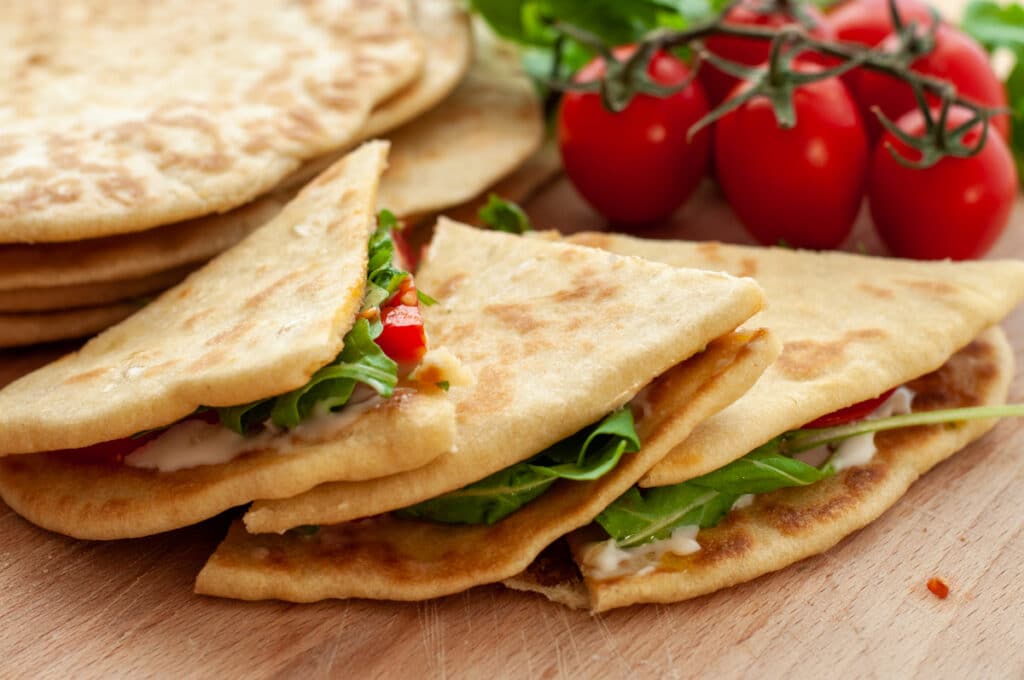
Ingredients
To make the Piadina dough, you need the following ingredients:
- Flour: you can use all-purpose flour
- Baking powder: or baking soda
- Lard: lard will give the right flavor and consistency, but you can use olive oil instead
- Salt
- Water
See recipe card for quantities.

Instructions
Making the dough
- Mix all the dry ingredients in a large bowl
- Add the lard and the water
- Mix until combined
- Let the dough rest for 30 minutes, covered with a plastic wrap
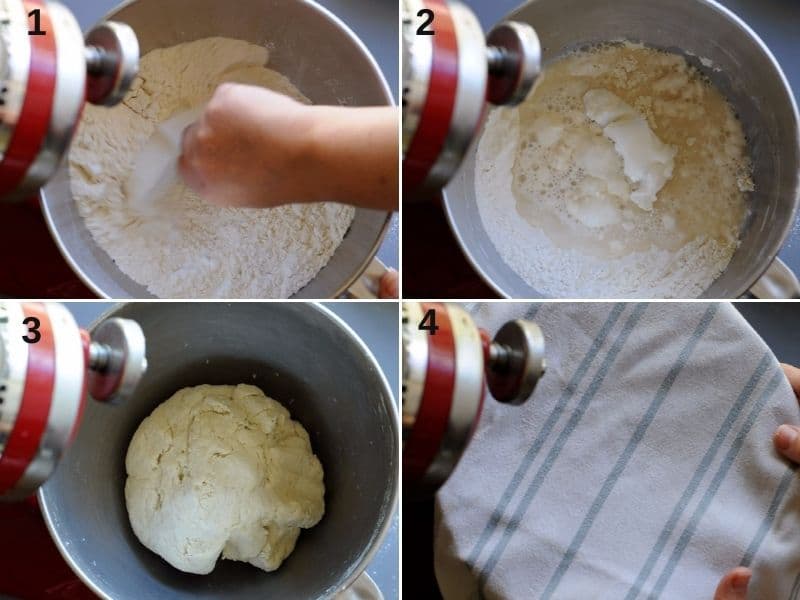
Shaping the Piadina
- Knead the dough by hand until it becomes smooth and uniform (1 minute)
- Cut the dough into eight equal pieces
- Roll it into small balls
- Let them rest for another 30 minutes, covered

- Roll down each dough ball into a flat round shape with a rolling pin
Hint: It is essential to leave the dough to rest for 30 minutes once mixed and another 30 minutes once formed into small balls. Do not skip these steps.

- You can also use a dough press
- Place a ball on parchment paper on the dough press
- Cover with another sheet of parchment paper
- Press down the top
- Lift it up
- Remove the flat round shaped piadina
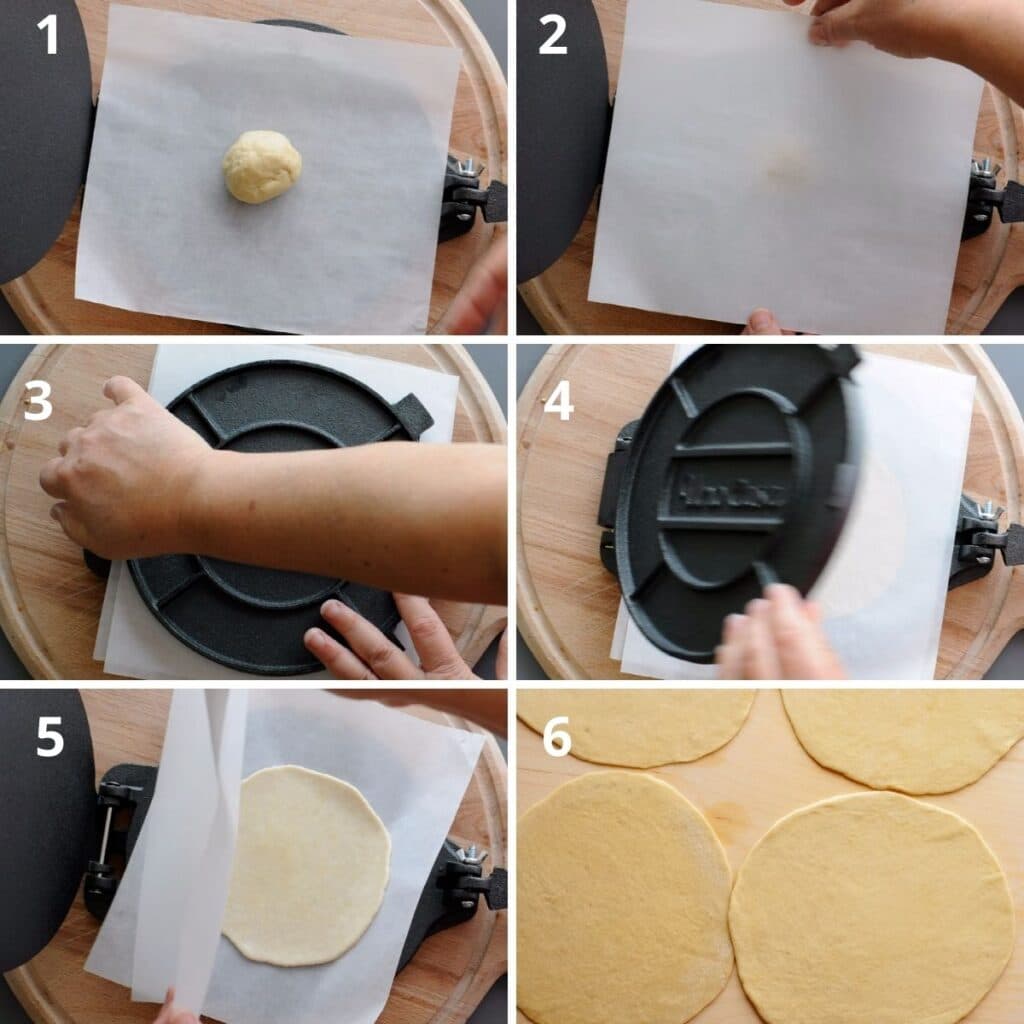
Cooking the Piadina
- Grill each piadina in a hot skillet (no fat or seasoning needed)
- Wait until it forms some bubbles on the top
- Turn it on the other side and cook until golden brown
- Pile them on a plate and serve them still warm with the filling of your choice.
Hint: you can also serve them cold, but warm is better

Filling it
The classic filling for a piadina sandwich is Squacquerone cheese. If you cannot find it, you can use stracchino cheese
- Spread the cheese on half of the piadina
- Place slices of fresh tomato on top
- Cover with rocket-arugula salad and season with salt and extra-virgin olive oil
- Fold the other half over and cut it into slices
Hint: La Piadina breaks easily when folded, which is why it is served cut into triangles
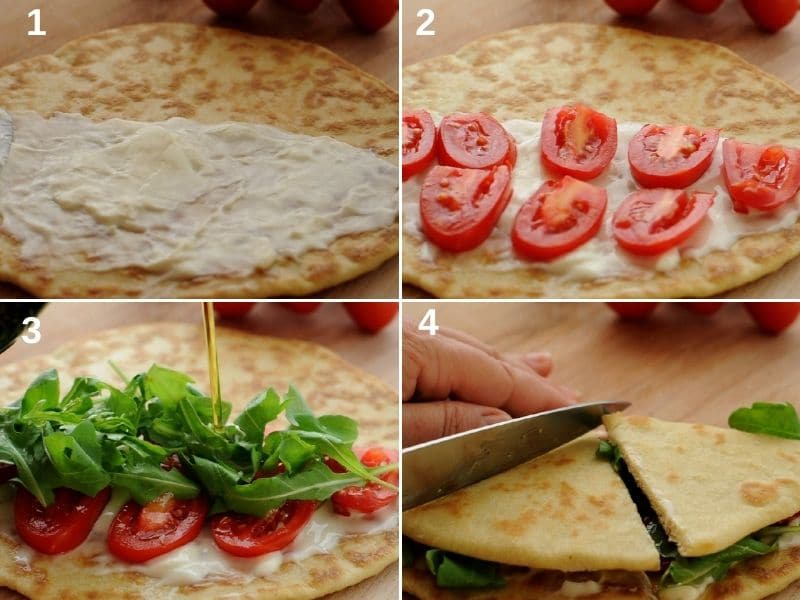
Substitutions
- For a vegetarian version, you can substitute the lard with olive oil.
- If you do not have baking soda, you can use baking powder, but do not use yeast.
- If you cannot find the squacquerone cheese, use other soft cheese stracchino or crescenza. You can buy them on Amazon.
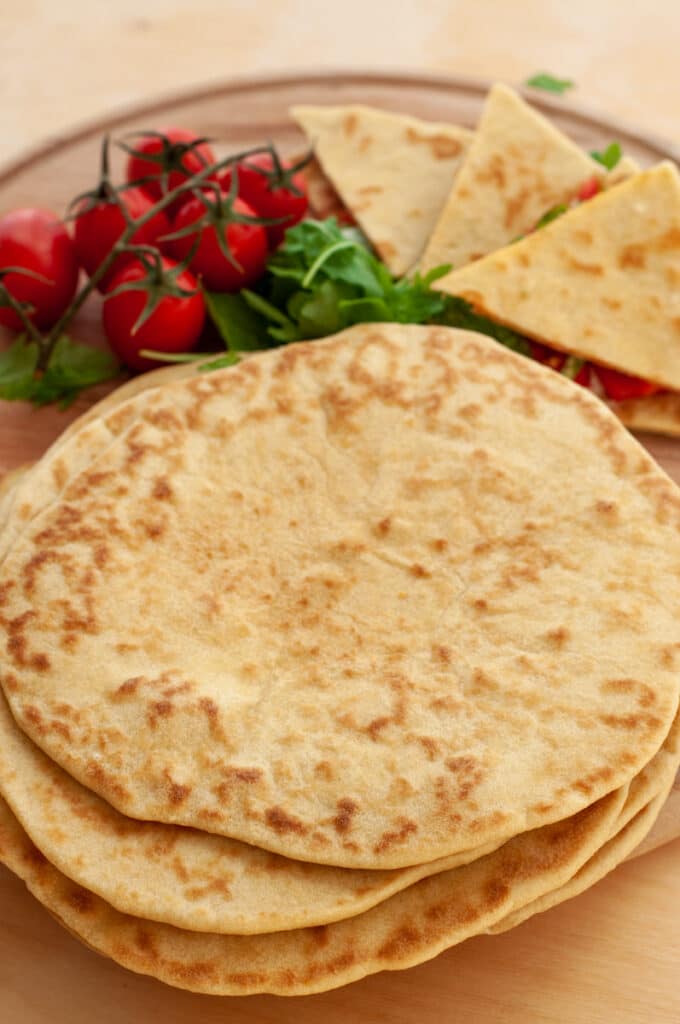
Variations
You can serve the Piadina sandwich with any filling you like, like a sandwich: cold cuts of cured meat like prosciutto crudo or Parma ham, salami, cheese, Mozzarella cheese, and tomatoes salad, spinach or a mix of grilled vegetables.
For vegetarian versions, you can check out the combination of vegetables and Italian cheeses I recommend in the article: 10 Vegetarian pizza topping.
They are:
- Gorgonzola cheese and radicchio
- Tomato and mozzarella cheese
- Fried eggplants and ricotta salata
- Pesto and stracchino
- Zucchini flowers and ricotta
- Grilled zucchini and scamorza
- Roasted red peppers and Parmigiano Reggiano
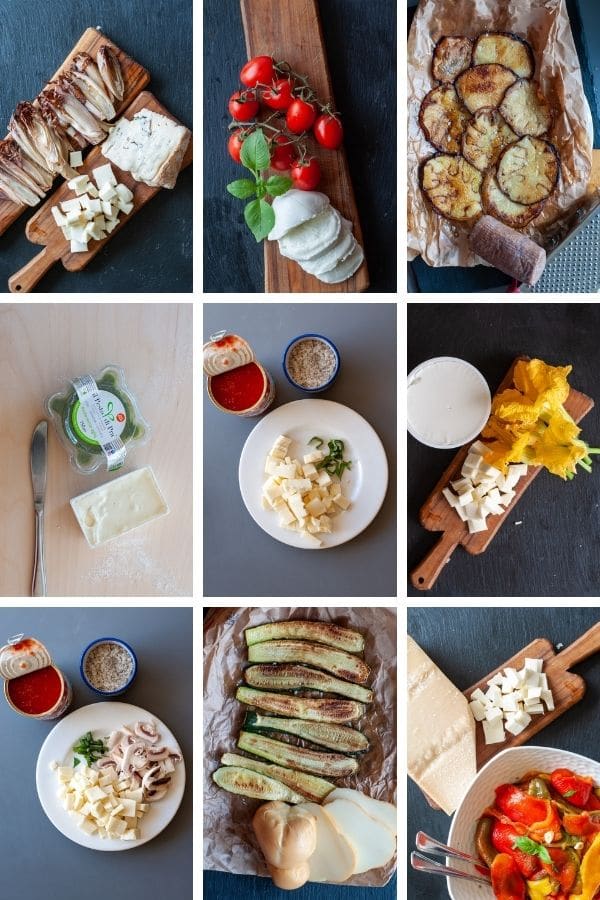
Equipment
You can make the piadina dough with your hands and shape them with a rolling pin. However, I found it very convenient to use a dough press, the same one used to shape the tortillas.
I also use my kitchenAid mixer to mix the dough, but it is optional. The dough is very easy to knead by hand.
To cook the Piadina, it is best to use a skillet or a pan for crepes as the edges are low, and it is easier to turn them.

Storage
You can keep the dough in the fridge for a few days, wrapped in cling foil. Although this dough is not suitable for the freezer as it contains baking soda.
The cooked Piadine can also be stored in the fridge for a few days and wrapped in cling film.
They should be served warm, and you can warm them up in the oven or on a grill.
I wouldn't recommend warming them up in the microwave as they will get soggy.
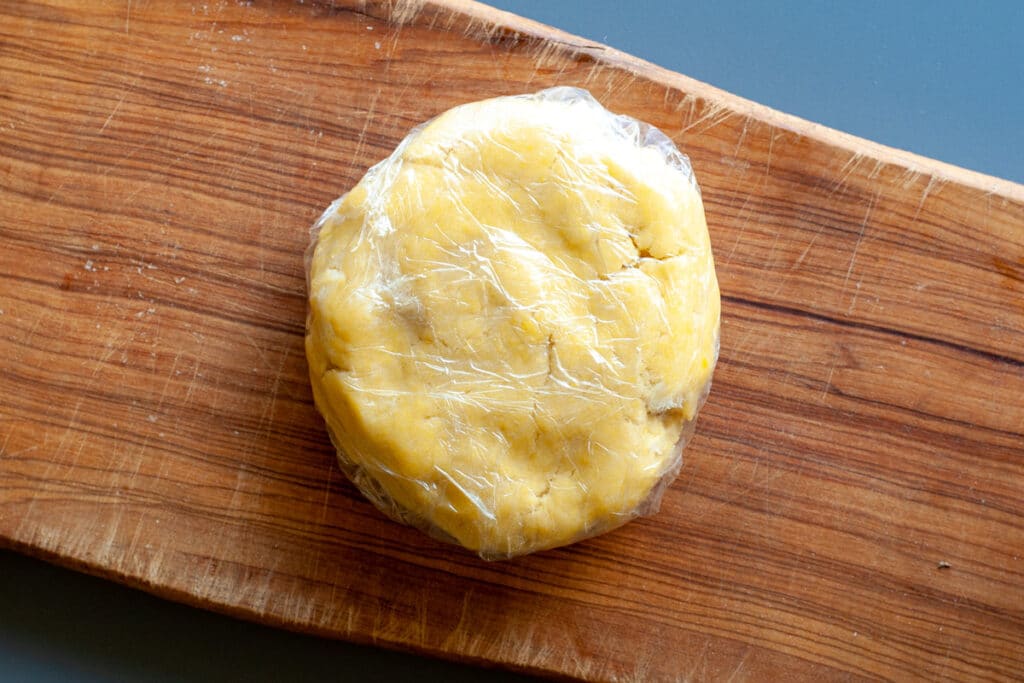
Top tip
Piadina is very crumbly and easy to break when folded.
That is why it is usually served cut into triangular slices.
Ensure the filling doesn't leak from the back while you eat it.
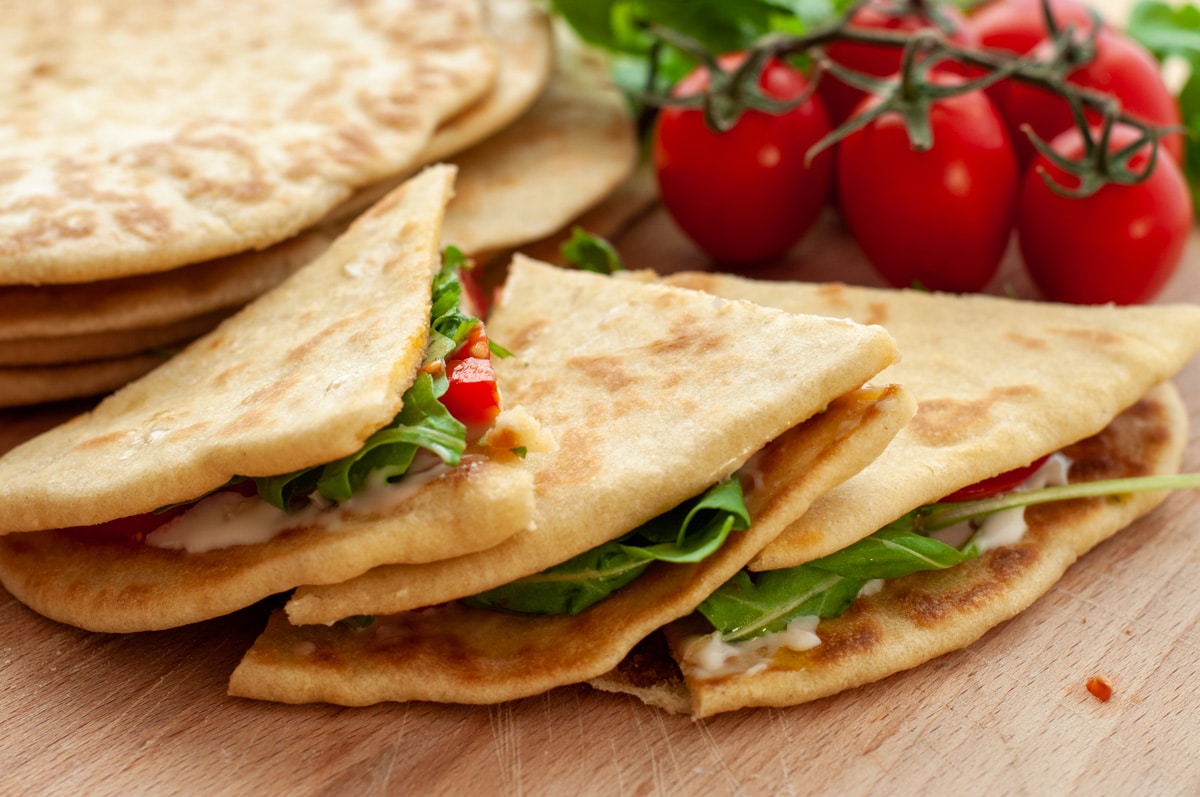
History about piadina
Flatbread has ancient origins from the late Neolithic period before the Egyptians invented yeast in 3000 and 2500 BC.
The Egyptian flatbread Aish Baladi goes back 6000 years ago. It was made with emmer wheat and cooked in an oven built with clay from the Nile river.
We find various types of flatbread everywhere around the world Naan India and Pakistan, Tortillas in South America, and Pita bread in Greece.
The first mention of food called "piada" dates back to the 14th century, in the Descriptio Romandiole, the census statistics commissioned for tax purposes, in 1371. The piadina flatbread was used to pay taxes.
In the Middle ages, we find the description of the piadina as a "bad food that many like so much" or "a kind of very ordinary, bad focaccia". It was cheap bread during famine and a rise in food prices.
La piada was nothing more than a substitute for bread which was used when, in the absence of wheat flour, they were forced to use ingredients unsuitable for bread-making: inferior cereals (spelt, millet, sorghum, rye, barley) , broad beans, beans, grass peas, vetches, chestnuts, acorns, bran and worse.
After the Second World War, thanks to improved living conditions, the low-quality piada became the good plain wheat piada in the countryside and the cities and was no longer considered a substitute for bread but a delicious alternative.
In the 20th century, the piadina Romagnola gained the attribution of the PGI brand (Protected Geographical Indication) split into two main variants: Rimini area, wider and thinner in Forlì-Ravenna area, larger and more compact.
For more information about the history of flatbread you can watch this video on the Food History Channel TV.
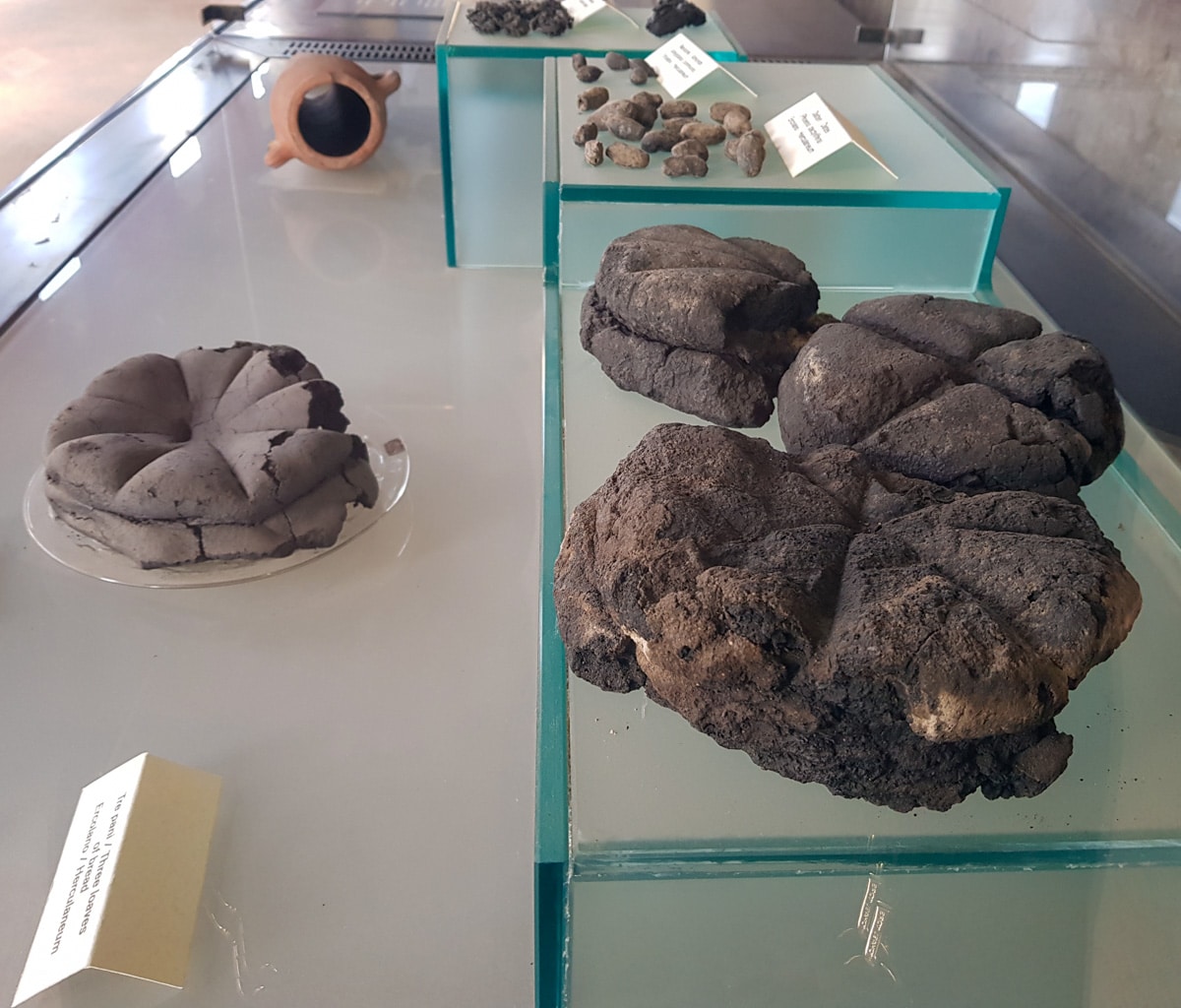
FAQ
Piadina is very similar to the Tortilla, but while the tortilla is smooth and flexible, the Piadina is tastier and crumbling. The Piadina breaks more easily when folded, so it is never rolled like a tortilla and is often served cut in rectangular slices.
Piadina should be served warm, and you can warm it up in the oven or on a grill. I wouldn't recommend warming them up in the microwave as they will get soggy.
More bread recipes
If you are making the Authentic Piadina Recipe Italian Flatbread, leave your comment below I would like to hear from you. You can find more delicious ideas if you FOLLOW ME on Facebook, YouTube, or sign up to my newsletter.
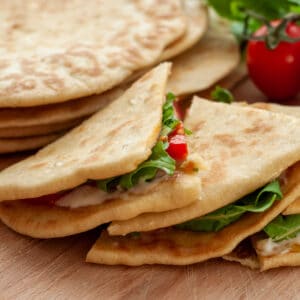
📋Authentic Piadina Recipe Italian Flatbread
Ingredients
For the filling
- 7 oz stracchino or squacquerone
- 4 fresh tomatoes
- 5 oz prosciutto optional
- 3 cups wild rocket - arugola salad
- 8 teaspoon extra virgin olive oil
- salt
Equipment
- Dough Press optional
Instructions
Making the dough
- Mix all the dry ingredients together4 cups flour, 1.5 teaspoon baking soda, 1 teaspoon salt
- Add the lard and the water3.5 oz lard, 1 cup fresh water
- Mix until combined
- Let the dough rest for 30 minutes covered
Shaping the Piadina
- Knead the dough by hand until it becomes smooth and uniform (1 minute)
- Cut the dough into 8 pieces and roll it into small balls
- Let them rest for another 30 minutes covered
- Roll down each ball flat with a rolling pin
You can also use a dough press
- Place a ball on parchment paper on the dough press
- Cover with another sheet of parchment paper
- Press down the top
- Lift it up and remove the flat piadina
Cooking the Piadina
- Grill each piadina in a hot skillet
- Wait until it forms some bubbles on the top
- Turn it on the other side and cook until golden brown
- Pile them on a plate and serve them still warm with the filling of your choice.
Filling it
- Spread the cheese on half of the piadina7 oz stracchino
- Place slices of fresh tomato on top and a slice of prosciutto4 fresh tomatoes
- Cover with rocket and season with salt and extra virgin olive oil5 oz prosciutto, 3 cups wild rocket - arugola salad, 8 teaspoon extra virgin olive oil, salt
- Fold the other half over and cut into slices and serve
Video
Notes
- It is important to leave the dough rest 30 minutes once mixed and another 30 minutes once formed into small balls. Do not skip these steps.
- you can serve Piadina cold, but warm is better
- If you are not using the dough immediately keep in the fridge wrapped in cling foil
- La Piadina breaks easily when folded, that is why it is never rolled like a tortilla and it is often served cut in rectangular slices.
Nutrition
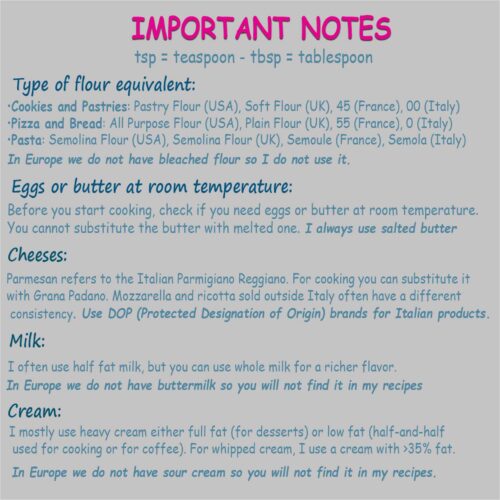

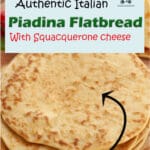



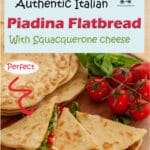

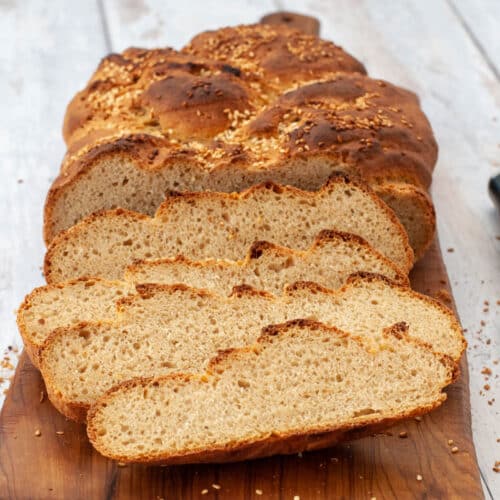
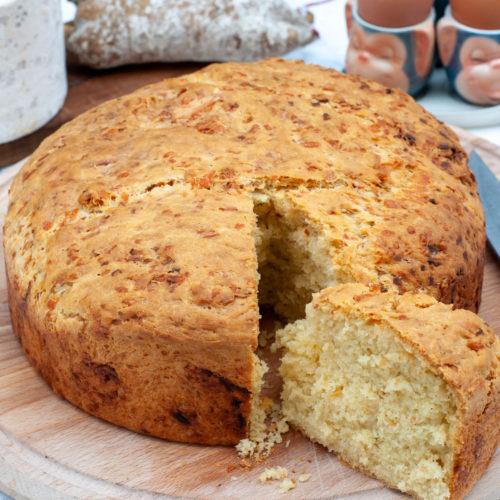
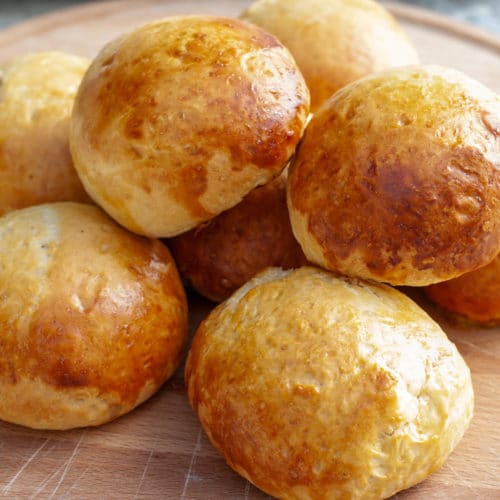
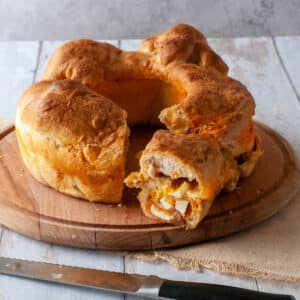
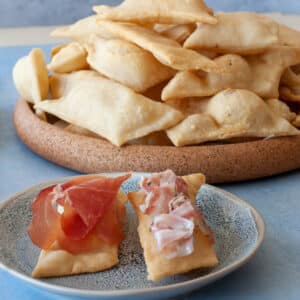
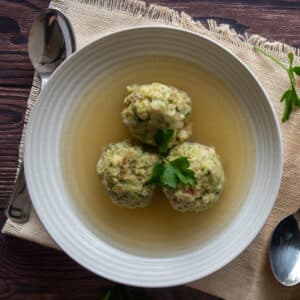
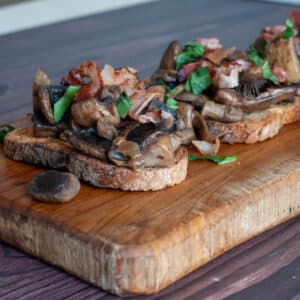
Leave a Reply